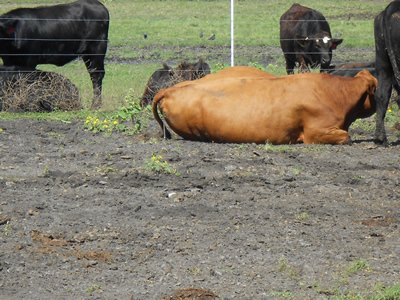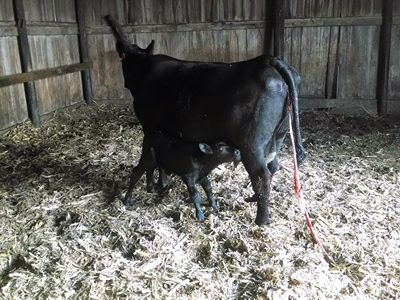Calving Management
Calving Process and Stages of Delivery
It is important to understand the calving process and stages of delivery because it can help you recognize normal progression as well as times when you should intervene. At the end of gestation a cow must successfully transition through the delivery process. To do this, cows must negotiate the three stages of delivery with the goal of delivering a live calf. Remember that calving is a strenuous event for cows and dams need to be consuming adequate pre-calving nutrition.
Stage 1
The first stage of labor (video) begins with the dilation of the cervix. In this stage, the cervical plug has dissolved and uterine muscles begin to contract. In many cases, cows in stage 1 labor will go unnoticed as there are not any obvious visible signs of parturition. However, astute observers can identify changes in behavior that signal the beginning of parturition. Most cows will become restless or show some evidence of discomfort. Another key behavioral change is that cows will isolate themselves from the herd as they prepare for the upcoming birth. As cows move through stage 1, you can occasionally see vaginal discharge and an elevation of the tail. In the days prior to parturition, the pelvic area will become relaxed and the cow’s udder will begin to fill. When parturition begins, these events should have been completed and the pelvic area will be completely relaxed or softened and the udder should be full.
Normally, stage 1 of labor lasts 2-6 hours but can take up to 8-12 hours for heifers. If a cow has not progressed through stage 1 labor in 6-8 hours, then that is an indication that something may not be right and assistance is warranted. However, good observation is required to know when stage 1 begins as it is often missed by casual observation.
Stage 2
The major event in the second stage of labor (video) is the delivery of a newborn calf. Stage 2 begins when the cervix is completely dilated and the fetus enters the pelvis or birth canal. During this time fetal membranes such as the water bag will become visible followed by the calf itself. In addition to these signs of calving, stage 2 is also characterized by active labor of the cow. The cow will be actively straining to expel the calf that will include the incorporation of an abdominal press. Stage 2 can take up to 2 to 4 hours; but typically in uncomplicated deliveries may only take 30 to 60 minutes. Females can be allowed to continue in stage 2 labor as long as they are making consistent progress in delivering the calf. However, if a cow or heifer has been in stage 2 labor and not making progress, then assistance should be provided. A good rule of thumb is that if a female is in active labor for 30 minutes and not making progress, then help should be provided. Additionally, if the cow becomes exhausted, the calf is stressed or an abnormal presentation is evident then assistance should be provided. Calves that are being stressed during delivery may be difficult to detect; however one sign of a stressed calf is the presence of meconium (yellow) staining on the calf. This is much easier to identify in calves that have white legs or white on their head. Another sign of a stressed calf is a swollen tongue. Once stage 2 labor begins, intervention is not detrimental as long as it is carefully applied and not rushed.
Stage 3
After the calf is delivered, the cow will expel the placenta. Usually this happens soon after delivery, but the process may take up to 8 to 12 hours after delivery. After 12 hours, the cow is considered to have retained fetal membranes or a retained placenta. However, treatment is usually not warranted and the membranes will usually be expelled on their own eventually (up to 4 days post-calving) without harm to the cow. To avoid injuring the cow’s uterus or causing excessive bleeding, you should not attempt to pull the placenta. If a placenta is not passed within four days of calving, contact your veterinarian for assistance.
Calving Observation
One of the most critical aspects of reducing the impact of dystocia is observation of close up cows to identify calving problems early. Proper intervention can result in a live healthy calf and cow instead of a stillborn calf and/or an injured cow. Data from the USDA:NAHMS indicates that 60% of cattle producers observe pregnant females only once or twice a day during calving. Cows should be checked at least every four hours and heifers ideally should be checked every two hours. Cows in stage 1 labor should be identified and monitored to make sure they progress into stage 2. Cows in active labor should be observed closely to make sure they are making progress or assistance given. Once active labor starts (stage 2), it is not detrimental to provide assistance and ensure a positive outcome of a live, healthy calf.
Practically managing late term cows can be complicated. From a calving observation and calf delivery standpoint, it is common to congregate females in a calving area that is close to the residence and barn, and small enough to easily walk through and observe cows. However, from a disease prevention perspective, larger calving areas that decrease pathogen buildup such as the Sandhills Calving System are commonly promoted. Careful deliberation of all of these attributes should be considered to develop a calving management system that allows for the successful delivery of a healthy calf that can continue to thrive.
One way to improve observation is to feed cattle in a manner that promotes daytime calving, called the "Konefal feeding method." Although the physiology is still not well understood, multiple studies have shown that feeding cows in the evening leads to a significantly greater proportion of cows that calve during the day. Most studies have evaluated feeding cows either at dusk or 9 p.m., and in most cases the result has been approximately 82% cows calving between 6 a.m. and 10 p.m. Perhaps the best thing about nighttime feeding is that it takes almost no advanced planning to see results. Existing data indicate that cattle on a nighttime feeding regimen for as little as a week before calving have similar calving patterns as those fed in the evening for multiple weeks. In systems where cows are fed twice daily, feed the bulk of the ration in the evening to take advantage of this effect.
Because many operations do not feed a total mixed ration to the cow herd, but rather supplement grain to a round bale-based diet, there can be logistical challenges. However, many producers have experienced success by restricting access to hay during the day and turning cows on to bale feeders from dusk to dawn. Limited access should not cause problems with total daily intake if forage quality is adequate. Research conducted at Purdue University suggests that cows can consume all of the dry forage they are going to eat in 6 hours per day.
| Contributors | |||||
|---|---|---|---|---|---|
| Grant Dewell | Renée Dewell | Katy Lippolis | |||
Associate Professor |
Veterinary Specialist Center for Food Security/Public Health rdewell@iastate.edu 970-231-9654 |
||||



